16. Exporting Frames, Clips, and Sequences
Lesson overview
In this lesson, you’ll learn how to do the following:
Choose export options.
Export single frames.
Create movie, image sequence, and audio files.
Use Adobe Media Encoder.
Upload to social media and Adobe Stock.
Work with edit decision lists for project sharing.
![]() This lesson will take about 90 minutes to complete. To get the lesson files used in this chapter, copy them from the DVD that accompanies the print book, or download them from the web page for this book at www.adobepress.com/PremiereProCIB2021. Store the files in a convenient location on your computer. For more information, see “Accessing the lesson files and Web Edition” in the Getting Started section at the beginning of this book.
This lesson will take about 90 minutes to complete. To get the lesson files used in this chapter, copy them from the DVD that accompanies the print book, or download them from the web page for this book at www.adobepress.com/PremiereProCIB2021. Store the files in a convenient location on your computer. For more information, see “Accessing the lesson files and Web Edition” in the Getting Started section at the beginning of this book.

One of the best things about editing video is the feeling you have when you can finally share it with your audience. Adobe Premiere Pro offers a wide range of export options. You can export to multiple high-level output formats using simplified quick export presets, fully detailed settings, or even via Adobe Media Encoder for export in batches.
Starting the lesson
The most common form of media distribution is via digital files. Whether your completed project will be shown on a television, at the cinema, or on a computer screen, you will usually deliver a file that has the particular specifications required for that medium.
To create a file, you can export directly from Premiere Pro or use Adobe Media Encoder. Adobe Media Encoder is a stand-alone application (included with your Creative Cloud membership) that handles file exports in batches, so you can export in several formats simultaneously and process in the background while you work in other applications, including Premiere Pro and Adobe After Effects.
![]() Note
Note
This book assumes that Premiere Pro is using default settings. To reset the application preferences to their defaults, quit Premiere Pro; then hold down Option (macOS) or Alt (Windows) and restart the application. When a confirmation dialog appears, release the key and click OK.
Making quick exports
Premiere Pro offers a quick export option that’s perfect when you simply want to export a media file with settings that are appropriate for your current sequence or clip with the minimum number of clicks. This method produces H.264 MP4 files, which are perfect for uploading to social media or to streaming services.
Let’s give it a try.
Open Lesson 16.prproj from the Lessons folder.
Save the project as Lesson 16 Working.prproj.
Open the sequence Review Copy.
Click the Quick Export icon
 in the top-right corner of the Premiere Pro window to open the Quick Export dialog box.
in the top-right corner of the Premiere Pro window to open the Quick Export dialog box.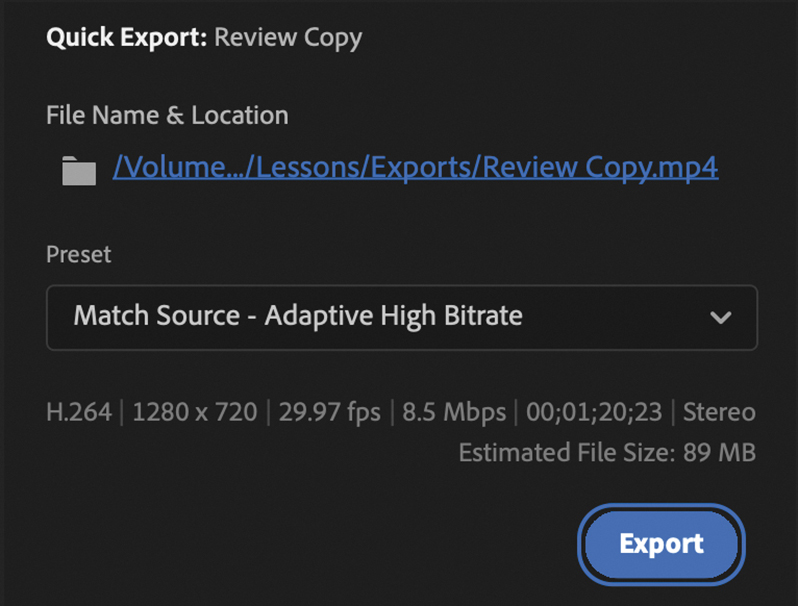
The blue text showing the output name is actually a button that opens a Save As dialog box. You’ll find the same type of text-as-a-button in Adobe Media Encoder. Click the output name now. Choose a location and name the file Review Copy.mp4.
Use the Preset menu to choose Match Source — Adaptive High Bitrate. These settings automatically match the format of your sequence (or clip if you had selected one to export).
There are also high quality 4K (Ultra High Definition), HD (High Definition), and SD (Standard Definition) presets available that will conform your export to a particular delivery standard.
A summary displays the settings you have chosen.
Click Export to create your new media file.


Understanding the full media export options
Whether you’ve completed a project or you just want to share an in-progress version for review, you have several export options.
You can export to an appropriate file type, format, and codec for your chosen delivery medium.
You can export a single frame or a series of frames.
You can choose audio-only, video-only, or full audio/video output.
Captions can be included, embedded in the output file or stored in a separate file.
Exported media can be reimported into the project automatically for easy reuse.
![]() Note
Note
The content that’s selected when you choose File > Export is what Premiere Pro will export. This can consist of clips, sequences, or parts of clips or sequences.
Beyond choosing an export format (frame size, frame rate, and so on), there are several other important options when exporting a file:
You can choose to create files in a similar format and at the same visual quality and data rate as your original media, or you can compress them to a smaller size to make distribution easier.
You can transcode your media from one codec to another to make it easier to exchange with creative collaborators.
You can set the frame size, frame rate, data rate, or audio and video codec and configuration if an existing preset doesn’t fit your needs.
You can apply a color lookup table (LUT) to assign a Look. You can also apply a video limiter, HDR to SDR conversion, and audio normalization.
You can burn-in timecode, name, or image overlays.
You can upload an exported file directly to social media accounts, an FTP server, or Adobe Stock.
Exporting single frames
Even while an edit is in progress, you may want to export a still frame to send to a team member or client for review. You might also want to export an image to use as the thumbnail of your video file when you post it to the Internet.
When you export a frame from the Source Monitor, Premiere Pro creates a still image that matches the resolution of the source video file.
When you export a frame from the Program Monitor, Premiere Pro creates a still image that matches the resolution of the sequence.
Let’s give it a try.
Continue working with the sequence Review Copy. Position the Timeline playhead on a frame you want to export.

In the Program Monitor, click the Export Frame button
 on the lower right. If you can’t see the button, resize the Program Monitor.
on the lower right. If you can’t see the button, resize the Program Monitor. Note
NoteIf you don’t see the button, you may need to resize the panel. It might also be because you’ve customized the Program Monitor buttons. You can select the Program Monitor or the Timeline panel and press Shift+E (macOS) or Shift+Ctrl+E (Windows) to export a frame.
In the Export Frame dialog box, enter a filename.
Choose a still-image format from the Format menu.
JPEG, PNG, and BMP (Windows only) are universally readable. JPEG and PNG files are commonly used in website design.
TIFF, TGA, and PNG are suitable for print and animation workflows.
DPX is often used for digital cinema or color-grading workflows (fine color finishing).
OpenEXR is used to store high dynamic range picture information.
 Note
NoteIf your video format uses non-square pixels, the resulting image file will appear to have a different aspect ratio. This is because still image formats have square pixels. Using Adobe Photoshop, you can resize the image horizontally and restore the original aspect ratio.
Click the Browse button to choose a location to save the new still image. Create a folder named Exports in the Lessons folder, select it, and click Choose.
 Note
NoteIn Windows, you can export to the BMP, DPX, GIF, JPEG, OpenEXR, PNG, TGA, and TIFF formats. In macOS, you can export to the DPX, JPEG, OpenEXR, PNG, TGA, and TIFF formats.
Select the Import Into Project option to add the new still image into your current project, and click OK.
 Note
NoteIf you export a TIFF file from Premiere Pro, the file will have a three-letter .tif file extension, rather than .tiff. Both are valid and work interchangeably.
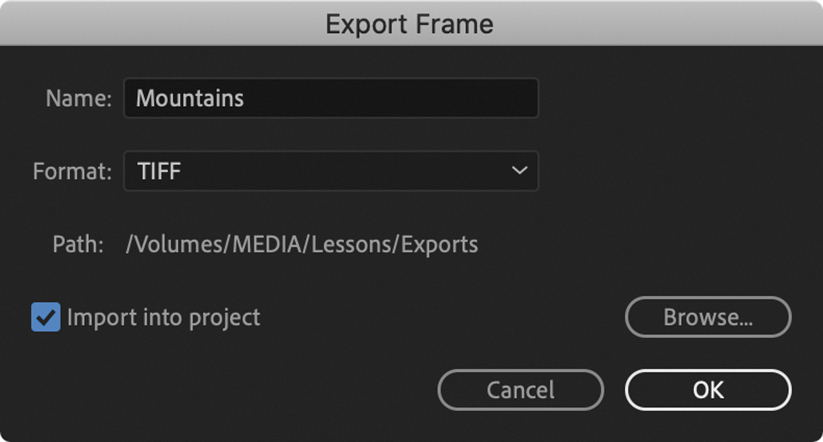
The new still image is created, and a clip linked to it is added to the Project panel.
Exporting a master file
A master copy is a pristine digital copy of your edited project that can be archived for future use. It’s a self-contained, fully rendered output file from your sequence at the highest resolution and best quality possible. You can use a file of this kind as a source media file to produce other compressed output formats without opening the original project in Premiere Pro.
Though basing other copies on this digital master technically means losing a tiny amount of quality (one digital generation), the loss is so minimal relative to the convenience and time-savings that many editors find it a worthwhile exchange.
Matching sequence settings
Ideally, the frame size, frame rate, and codec of a master file will closely match the sequence it’s based on. It can seem like a lot of settings to think about when creating a new exported media file. Thankfully, Premiere Pro makes matching your sequence or original clip settings easy.
Continue working with the Review Copy sequence.
With the sequence selected in the Project panel or open in the Timeline panel, with that panel active (with a blue outline), choose File > Export > Media. The Export Settings dialog box opens. You can also press Command+M (macOS) or Ctrl+M (Windows).
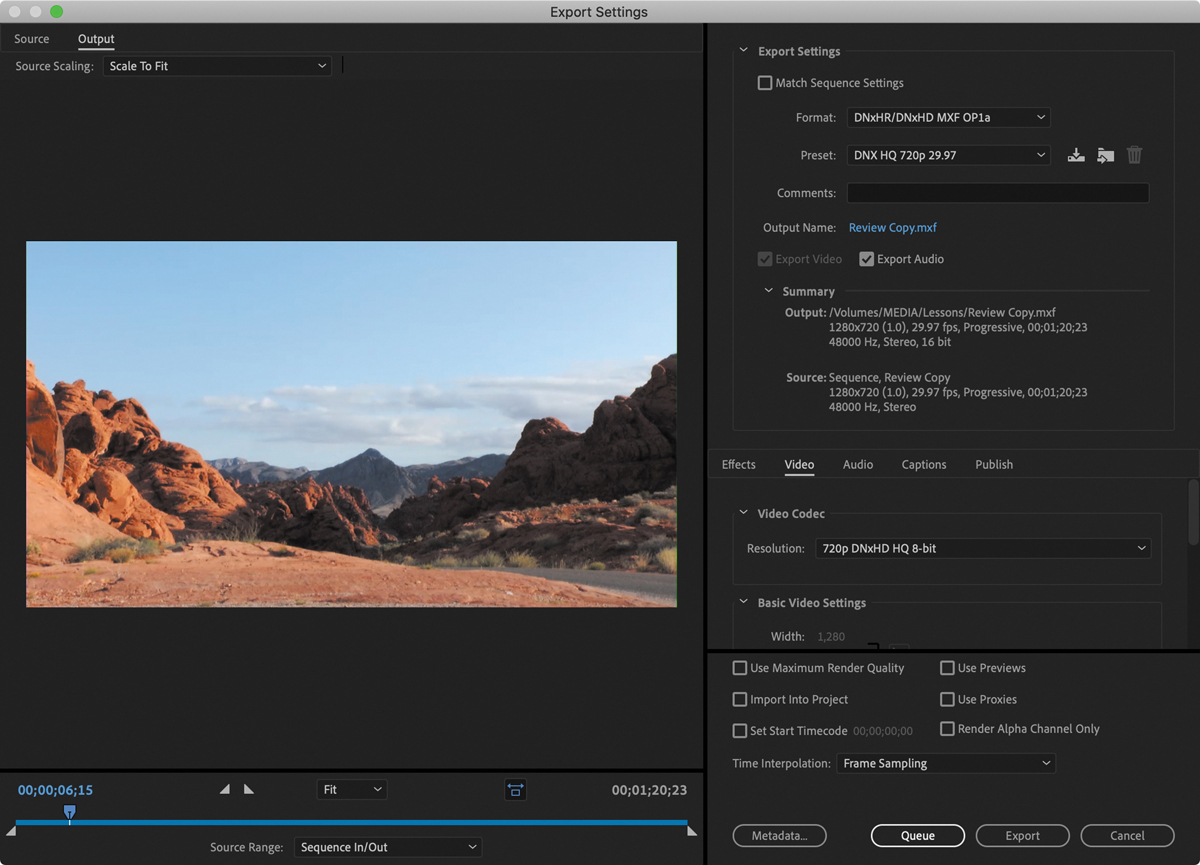
You’ll learn more about this dialog box later. For now, select the Match Sequence Settings option.

Click the blue text to choose a name and location for your exported media file.

 Note
NoteIn some cases, the Match Sequence Settings option cannot produce an exact match of the original camera media. For example, XDCAM EX will write to a high-quality MPEG2 file. In most cases, the file written will have an identical format and closely match the data rate of the original sources.
Choose a target location (for now, use the Exports folder you created earlier), name the file Review Copy 01 (don’t worry about the file extension—it will be added automatically), and click Save.
 Note
NoteThe number in parentheses in the export summary is the pixel aspect ratio.
Review the Summary information to check that the output format matches the sequence settings. In this case, you should be using DNxHD media (as MXF files) at 29.97 fps. The Summary information is a quick, easy reference that helps you avoid minor errors that can have big consequences. If the Source and Output Summary settings match, it minimizes conversion, which helps maintain the quality of the final output.
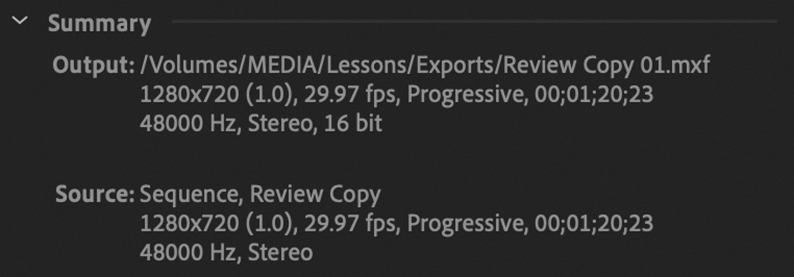
When exporting a sequence, the sequence itself is the source in the Export dialog box—not the clips inside the sequence, because these will have already been conformed to the sequence settings.
Click the Export button to create a media file based on the sequence.
Choosing the source range
You don’t have to export a whole sequence. In fact, you’ll commonly export only a selected part of your sequence for review or distribution, particularly for social media where durations are often short.
Choose File > Export > Media to bring up the Export Settings dialog box again. In the upper-left corner, there are Source and Output tabs. The Output tab (displayed by default) shows a preview.
You’ll find the Source Range controls on the lower left. If your source sequence or clip has In and Out points, they are automatically used. You can change that by choosing an option from the Source Range menu.
You can apply new In and Out points by dragging the small triangular handles along the navigator directly above the menu or by positioning the playhead on the navigator and then clicking the Set In Point and Set Out Point buttons or pressing I and O.

If you adjust the source range here, the Source Range menu updates to show Custom.
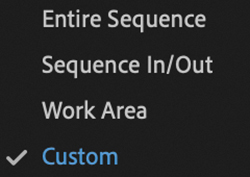
Cropping the source during export
While exporting, you can crop to resize your source (that is, the sequence or clip that you are exporting) independently of the output frame size. You might crop to change the source aspect ratio or perhaps as a last-minute decision to exclude part of the visual contents.
Click the Source tab at the top left to bring it to the front. The Source tab gives access to cropping controls. Click the Crop The Output Video button
 to enable the controls.
to enable the controls.
You can enter specific values (in pixels) at the top of the dialog box or drag the handles in the Source preview to crop the image.
The Crop Proportions menu has several options to restrict the settings to a particular aspect ratio. Choose 4:3 from the Crop Proportions menu. Now, if you make changes to the crop values, the values will be locked to a 4:3 aspect ratio.

Click the Output tab to bring it to the front.

The Output tab shows a preview of the video to be encoded. The Source Scaling menu lets you choose the way a mismatch between the source aspect ratio and the output settings is displayed.
Try a few options in the Source Scaling menu to see the results. The option Change Output Size To Match Source is not available for all export formats. It achieves the same result as clicking the Match Source button on the Video tab in the Export settings. Leave the Source Scaling menu set to Scale To Fit.
After making changes on the Source tab or choosing a new output frame size, it’s always a good idea to check the Output tab to spot errors such as unwanted letterboxing or distortion caused by the irregularly shaped pixels used in some video formats.
Click Export. Premiere Pro creates the new media file.
When you export a file with black bars at the top or sides, those bars become part of the file. In this case, you created a 16×9 file that includes black pixels. These black pixels are sometimes desirable as it helps to ensure the image will be displayed with the correct aspect ratio on a 16×9 screen.
Choosing another codec
When you export to a new media file, you can choose the format and codec that will be used. Some camera capture formats (such as the H.264 MP4 files commonly produced by DSLR cameras) are already heavily compressed, to save storage space. Using a higher-quality mastering codec can help to preserve quality.
![]() Tip
Tip
Even if your original media is 8 bit, it is likely you will have been editing using higher-quality effects. The subtle results can be better captured in a 10-bit file than an 8-bit file.
Choose your format preset, decide whether you’d like to export audio, video, or both, and then modify the settings to suit.
With the Timeline panel active, press Command+M (macOS) or Ctrl+M (Windows) to display the Export Settings dialog box. Open the Format menu, and choose QuickTime. In the Preset menu, choose Apple ProRes 422.
This is a rather specific-sounding preset, but it’s just that—a preset, which preselects options from other menus in this dialog box that you can change if you need to.
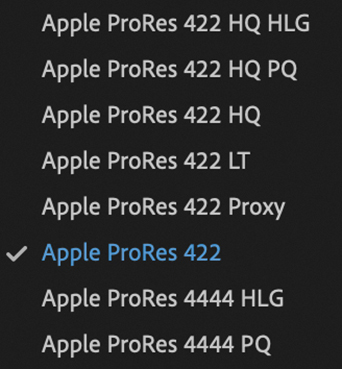
Click the output name (the blue text), and give the file a new name, Review Copy 02. Navigate to the same destination you used in the previous exercise, and click Save.
Below the Export Settings area you’ll find a series of tabs containing important additional options. Click a tab name to view it.

Here’s an overview:
 Note
NoteOn the Video tab, you’ll also find the option Render At Maximum Depth. When working without GPU acceleration, this can improve the visual quality of your output by using greater precision to generate colors. However, this option can add to the render time. Match this setting in the sequence settings to ensure the results are consistent.
Effects: You can add a number of useful effects and overlays as you output your media (see these options in the section “Applying effects during export.”
Video: The Video tab allows you to set the frame size, frame rate, field order, and profile. The settings available are based on the preset you chose.
Audio: The Audio tab allows you to adjust the bit rate of the audio and, for some formats, the codec. The default settings are based on the preset you chose.
Multiplexer: These settings specify whether the video and audio will be combined or delivered as separate files. These controls also let you determine whether the file will be compatible with a specific hardware device (such as a set-top box or media server).
 Note
NoteThe settings displayed change depending on the format you choose. Most of the critical options are accessed in the Video and Audio tabs.
Captions: If your sequence has captions, you can specify whether they are ignored, “burned in” (added to the visuals permanently), or exported as a separate file (referred to as a sidecar file).
Publish: This tab lets you enter the details of several social media services for your file to be delivered to. You’ll learn more about this later in this lesson.
Click the Video tab to bring it forward. In the Video Codec section of the Video tab, browse the available codecs from the Video Codec menu.
 Note
NoteProRes is a professional codec that is supported natively by Adobe Creative Cloud applications. Like all codecs, it will play back only in media applications that support it.
Choose Apple ProRes 422 HQ. This produces a high-quality file, in 10 bit, that many editors choose for final delivery. You might need to scroll down or resize the panel to see all the settings.

When you change the settings, the Preset menu switches to Custom.
Scroll down to view the Basic Video Settings area of the Video tab. By default, the settings will match the source. The Match Source button will override all the manual settings below to match the output to the source.
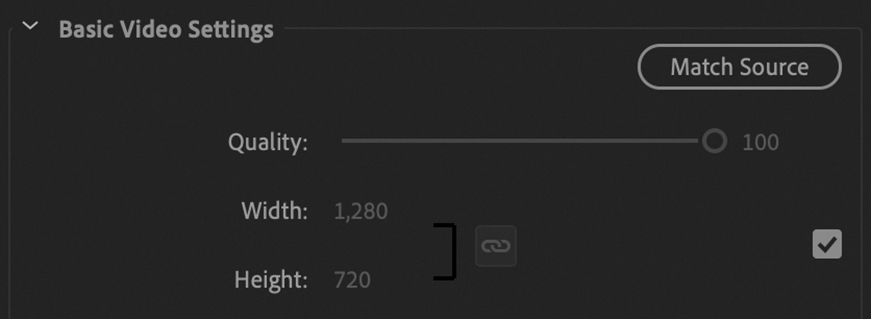
Click to select the Audio tab. In the Basic Audio Settings area, make sure 48000 Hz is chosen from the Sample Rate menu and 16 bit is chosen from the Sample Size menu. Just below that, in the Audio Channel Configuration area, make sure Stereo is chosen from the Output Channels menu.
These audio options are common standards for professional media delivery.

 Tip
TipHEVC/H.265 is a relatively new compression system formulated by the same Motion Picture Experts Group that brought us H.264. It’s more efficient, but fewer players support it. It also requires more hardware power than H.264. You may be asked to supply media using HEVC when producing 4K and UHD content.
Click Export at the bottom of the dialog box to export the sequence and transcode it to a new media file.
Apple ProRes 422 HQ is a high-quality option for professional media delivery that produces relatively large media files.
The most popular delivery format and codec is MPEG4 (.mp4), using the H.264 codec. These media files are smaller, so they are faster to upload to websites, and produce acceptable quality for most online viewing purposes. If you choose H.264 in the Format menu, you’ll find built-in presets for YouTube and Vimeo.
Applying effects during export
At the time of export, you can apply visual effects, add information overlays, and make automated adjustments to the output file.
Here’s an overview of the options on the Effects tab of the Export Settings dialog box:
Lumetri Look/LUT: Choose from a list of built-in Lumetri Looks or browse to your own, allowing you to quickly apply a nuanced adjustment to the appearance of your output file. This is most commonly used when viewing recordings at the end of each day of production (the dailies).
SDR Conform: If your sequence uses high dynamic range, you can produce a standard dynamic range version.
Image Overlay: Add a graphic, such as a company logo or network “bug,” and position it on-screen. The graphic will be incorporated into the image (burned in).
Name Overlay: Add a text overlay to the image. This is particularly useful as a watermark to protect your content or as a way to identify different versions.
Timecode Overlay: Display timecode for your finished video file, making it easy for viewers without specialized editing software to note reference times for commenting purposes.
Time Tuner: Specify a new duration or playback speed, up to +/–10%. This is achieved by applying subtle adjustments to periods of low action where the soundtrack is silent. Results vary depending on the media you are working with, so test different speeds to compare the end results. A continuous music soundtrack will interfere with the Time Tuner.
Video Limiter: Although it’s usually best to get your video levels right in the sequence, you can apply a limiter here too, to ensure your resulting file meets the required levels for broadcast television.
Loudness Normalization: Use the Loudness scale to normalize audio levels in your output file for broadcast television delivery. As with video levels, it’s best to get this right in the sequence, but it can be reassuring to know your levels will be limited during export.
Working with Adobe Media Encoder
Adobe Media Encoder is a stand-alone application that you can run independently of or launch from Premiere Pro. One advantage of using Media Encoder is that you can send an encoding job directly from Premiere Pro and then continue working on your edit as the encoding is processed. If your client asks to see your work before you finish editing, Media Encoder can produce the file in the background without interrupting your flow.
By default, Media Encoder pauses encoding when you play video in Premiere Pro to maximize playback performance. You can change this in the Premiere Pro Playback preferences.
Choosing a file format for export
It can be a challenge to know how to deliver your finished work. Ultimately, choosing delivery formats is a process of planning backward; find out how the file will be presented, and it’s usually straightforward to identify the best file type for the purpose. Often, clients will have a delivery specifications document to follow, making it easier to select the right options for encoding.

Premiere Pro and Adobe Media Encoder can export to many formats. In fact, Premiere Pro shares Adobe Media Encoder’s options.
![]() Note
Note
If you’re working with a professional mastering format (such as MXF OP1a, DNxHD MXF OP1a, or QuickTime), you can export up to 32 channels of audio. To do so, the original sequence must be configured to use a multichannel master track with the corresponding number of tracks.
Choosing a format
Adobe Media Encoder supports many formats. Knowing which setting to use can seem a little overwhelming. Let’s take a look at some common scenarios and review which formats are typically used. There are few absolutes, but these should get you close to the desired output.
It’s a good idea to test your output on a short section of your video before producing a full-length finished file. This will save you waiting for the complete version, only to discover there is a better setting to choose.
Encoding for user-generated video sites: The H.264 format includes presets for YouTube, Vimeo, Facebook, and Twitter in widescreen, SD, HD, and 4K.
Producing a DCP for theatrical distribution: Choose the Wraptor DCP format and then pick 24 or 25 frames per second. If your sequence is 30 frames per second, choose 24 frames per second for output to a DCP. Settings are limited to ensure compatibility with standard DCI-compliant cinema-projection systems.
In general, the Premiere Pro presets are proven and will work for your intended purpose.
Most Premiere Pro presets are conservative and will deliver good results with the default settings, so you probably won’t improve the quality by making adjustments.
Configuring the export
To export from Premiere Pro to Adobe Media Encoder, you’ll need to queue the export. The first step is to use the Export Settings dialog box to make choices about the file you’re going to export.
Continue working with the Review Copy sequence. Either select the sequence in the Project panel or have it open in the Timeline panel, with that panel active.
Choose File > Export > Media, or press Command+M (macOS) or Ctrl+M (Windows).
It’s best to work through the Export Settings dialog box from the top down, starting with the Export Settings area.
For this example, choose H.264 from the Format menu.
In the Preset menu, choose Vimeo 720p HD.
These settings match the frame size and frame rate of the sequence.
Click the output name (the blue text) and give the file a new name, Review Copy 03. Save it to the same destination you selected in the previous exercise.
Check the Summary information text to verify your choices.
Queuing the export
When you’re ready to create your media file, you have a few more options to consider. These are found in the lower-right portion of the Export Settings dialog box and apply regardless of whether you are exporting directly from Premiere Pro or queueing the export in Adobe Media Encoder.

Use Maximum Render Quality: Consider enabling this setting when scaling down from larger image sizes to smaller image sizes to produce the highest quality output possible. This option requires more RAM and can take longer to encode. This option is usually required only when working without GPU acceleration (in software-only mode) or when using non-GPU accelerated effects.
Use Previews: When you render effects, preview files are produced that look like your original footage combined with the effects. If you enable this option, the preview files will be used as the source for the new export. This can save a significant amount of time that would otherwise be spent rendering the effects again. The result might be lower quality, depending on the format of the sequence preview files (see Lesson 2, “Setting Up a Project”).
If you have configured your sequence previews to be very high quality and have rendered all effects already, this option can save an enormous amount of time when exporting—possibly 10x faster or more.
Use Proxies: If you have created and/or attached proxies to your media to speed up previews, Premiere Pro will normally always use the original media files for the purposes of exporting. If you select the Use Proxies option, the proxies will be used instead. This can speed up exporting in a similar way to the Use Preview option—and if your proxy media files are high quality, it may not reduce the output quality noticeably.
Import Into Project: This option automatically imports the newly created media file into your current project so you can review it or use it as new source footage.
Set Start Timecode: This allows you to specify a start timecode other than 00:00:00:00 for the newly created file. This is useful if you are working in a broadcast environment where a specific timecode start may be a delivery requirement.
Render Alpha Channel Only: Some post-production workflows require a separate grayscale file representing the alpha channel (the channel that defines opacity). This option produces that file, rather than a full-color version.
Time Interpolation: If your exported file will have a different frame rate than your sequence or source clip, this menu lets you specify the way the frame-rate change is rendered. The options are the same as those that apply when changing clip playback speed in a sequence.
Finally, there are these options to consider when exporting any kind of media file:

Metadata: Click this button to open the Metadata Export panel. You can specify a wide range of settings, including information about copyright, creator, and rights management. You can even embed useful information such as markers, script, and speech transcription data for advanced delivery options. In some cases, you may prefer to set the Metadata Export Options setting to None, removing all metadata.
Queue: Click the Queue button to send the file to Adobe Media Encoder, which will open automatically, allowing you to continue working in Premiere Pro while the export takes place.
Export: Select this option to export directly from the Export Settings dialog box rather than sending the file to the Adobe Media Encoder queue. This is a simpler workflow and usually a faster export, but you won’t be able to edit in Premiere Pro until the export is complete.
Click the Queue button to send the file to Adobe Media Encoder.

Media Encoder will not begin encoding automatically. To begin encoding, click the Start Queue button
 in the upper-right corner.
in the upper-right corner.To add another item to the queue, choose more export settings in Premiere Pro and click the queue button. Adobe Media Encoder will encode items in the order that they are added to the queue.

Exploring additional options in Adobe Media Encoder
Adobe Media Encoder brings a number of additional benefits. Although it involves a few extra steps beyond simply clicking the Export button in the Export Settings dialog box of Premiere Pro, the extra options are often worthwhile.
![]() Note
Note
Adobe Media Encoder does not have to be used from Premiere Pro. You can launch Adobe Media Encoder on its own and browse inside Premiere Pro projects to choose items to transcode.
Here are some useful features:
Add files for encoding: You can add files to Adobe Media Encoder by choosing File > Add Source. You can even drag files in from Finder (macOS) or Windows Explorer (Windows). There’s a Media Browser panel too, which you can use to locate items just as you would in Premiere Pro.
Import Premiere Pro sequences directly: You can choose File > Add Premiere Pro Sequence to select a Premiere Pro project file and choose sequences to encode without ever launching Premiere Pro.
Render After Effects compositions directly: You can import and encode compositions from Adobe After Effects by choosing File > Add After Effects Composition. Once again, you don’t need to open Adobe After Effects.
Use a watch folder: If you’d like to automate some encoding tasks, you can create watch folders by choosing File > Add Watch Folder and then assigning a preset to that watch folder. Watch folders exist in Finder (macOS) or Windows Explorer (Windows) like any other folder. Provided Adobe Media Encoder is running, media files placed into the folder can be automatically encoded to the format specified in the preset.
Modify a queue: You can add, duplicate, or remove any encoding tasks using buttons at the top of the list.

Modify settings: Once the encoding tasks are loaded into the queue, changing settings is easy; click the item’s Format or Preset entry (in blue text), and the Export Settings dialog box appears.

When encoding has completed, you can quit Media Encoder.
Uploading to social media
When encoding is complete, the next step is often to publish the video. In the Export Settings dialog box, you can configure publishing settings to automatically upload your video when encoding is complete.
The Publish settings allow you to upload exported videos to your synchronized Creative Cloud Files folder, Adobe Stock, Adobe Behance, Facebook, an FTP server (File Transfer Protocol is a standard way to transmit files to a remote file server), Twitter, Vimeo, and YouTube.
This powerful feature is particularly useful because the settings you choose can be incorporated into an export preset. This means you can configure your social media uploads once and have those settings apply to multiple future media uploads simply by choosing a preset.
Return to Premiere Pro.
Make sure the Timeline panel is active, and choose File > Export > Media or press Command+M (macOS) or Ctrl+M (Windows) to display the Export Settings dialog box.
Select the Publish tab to bring it to the front and review the options.

When you are ready, click Cancel to close the Export Settings dialog box.
Each platform has its own delivery standards, though in many cases you can choose a high-quality master file and let the platform do the work of producing more highly compressed alternative versions from that file. Adobe Stock, for example, supports a range of video formats and codecs. If you produce a high-quality UHD (3840×2160) file, the server can handle the rest.
Exchanging projects with other editing applications
Collaboration is an essential part of post-production. Premiere Pro can both read and write project files and footage files that are compatible with many of the top editing and color-grading tools on the market. This makes it easier to share creative work, even if you and your collaborators are using different editing systems.
Premiere Pro supports EDLs (Edit Decision Lists), OMF (Open Media Framework), AAF (Advanced Authoring Format), ALE (Avid Log Exchange), and XML (Extended Markup Language) import and export.
If you’re collaborating with an Avid Media Composer editor, you can use AAF as an intermediary, allowing the exchange of clip information, edited sequences, and some effects.
If you’re collaborating with an Apple Final Cut Pro editor, you can use XML as an intermediary similarly.
It’s straightforward to export an AAF or XML file from Premiere Pro; select a sequence you want to export and either choose File > Export > AAF or choose File > Export > Final Cut Pro XML.
For more information about best practices when sharing creative work between applications, see helpx.adobe.com/premiere-pro/using/exporting-projects-applications.html.
Exporting to OMF
Open Media Framework (OMF) is an industry-standard file type for exchanging audio information between systems (typically for audio mixing). When you export an OMF file, the typical result is a single file that contains all the audio files included in a sequence, arranged as clips on audio tracks. When the OMF file is opened by a compatible application, the clips will appear on tracks, timed and edited, just as they do in the Premiere Pro sequence.
Here’s how to create an OMF file:
With a sequence selected, choose File > Export > OMF.
In the OMF Export Settings dialog box, enter a name for the file in the OMF Title field.

Check that the Sample Rate and Bits Per Sample settings match your footage. The default settings, 48000 Hz and 16 bits, are the most common settings.
From the Files menu, choose one of the following:
Embed Audio: This option exports an OMF file that contains the project metadata and all the audio files for the selected sequence.
Separate Audio: This option separates all audio files, including stereo audio, into new multiple mono audio files, which are exported into a folder called omfiMediaFiles. This is a popular standard for audio engineers who are using advanced audio mixing workflows.
If you’re using the Separate Audio option, choose between the AIFF and Broadcast Wave formats. Both are high quality but check the option you need for the system you need to exchange with. AIFF files tend to be the most compatible.
From the Render menu, choose either Copy Complete Audio Files or Trim Audio Files (to reduce the file size). You can specify that handles (extra seconds) be added to give you some flexibility when modifying and mixing the clips.
Click OK to generate the OMF file.
 Note
NoteOMF files have a 2 GB file limit—if you’re working on a long sequence, you may need to separate it into two or more sections and export them separately.
Choose a destination, and click Save. You can use your Exports folder for now.
When the export is complete, the OMF Export Information dialog box appears. It displays information about the export and reports any errors that were encountered.
Click OK to close the dialog box.
Final practice
Congratulations! You have now learned how to import media; organize projects; create sequences; add, modify, and remove effects; mix audio; work with graphics and titles; and output to share your work with the world.
Now that you have completed this book, you may want to practice. To make this easier, the media files for a few productions have been combined in a single project file so you can explore the techniques you have learned.
Just for the record, these media files can be used only for personal practice and are not licensed for any form of distribution, including YouTube or any other online distribution, so please do not upload any of the clips or the results of any editing work you do with them. They are not for sharing with the public; they are just for you to practice with privately.
The Final Practice.prproj project file, in the Lessons folder, contains original clips for a few productions:
Andrea Sweeney NYC: This is a short road-movie diary piece. Use the voice-over as a guide to practice combining 4K and HD footage in a single timeline. Experiment with panning and scanning in the 4K footage if you choose to use HD sequence settings.
Bike Race Multi-Camera: This is simple multicamera footage. Experiment with live editing on a multicamera project.
Boston Snow: This is a mixture of shots of Boston Common filmed in three resolutions. Use this media to experiment with Scale To Frame Size, Set To Frame Size, and keyframe controls to scale shots. Try using the Warp Stabilizer effect to lock one of the high-resolution clips and then scale up the clip and create a pan from one side to the other.
City Views: This is a series of shots from the air and on land. Use these to experiment with image stabilization, color adjustment, and visual effects.
Desert: Use the diverse colors to try color correction tools and combine the footage with music to produce a montage.
Jolie’s Garden: This consists of atmospheric tableaux shot at 96 fps, set to play back at 24 fps, and filmed for a new feature film social media marketing campaign. Use these clips to experiment with the Lumetri Color panel Looks and speed change effects.
Laura in the Snow: This is media for a commercial shot at 96 fps, set to play back at 24 fps. Use this footage to practice color correction and grading adjustments. Experiment with ramping slow motion and masking both the video and the effects you apply.
Music: Use these music clips to practice creating an audio mix and editing visuals to music.
She: This is a series of stylized, mostly slow-motion clips that will be useful for experimenting with speed changes and visual effects.
TAS: This is footage from a short film, The Ancestor Simulation. Use this footage to try color grading and, as the footage is in two aspect ratios, mixing and matching the shots.
Theft Unexpected: This is footage from an award-winning short film directed and edited by the author. Use this footage to experiment with trimming, and practice adjusting timing in simple dialogue to achieve different comic and dramatic results, changing the actors’ performances.
Valley of Fire: Try color adjustments to bring variation and visual interest, use speed changes to transform the experience of flying across a desert, and keyframe the rotating view to compensate for the movement and produce a static shot.
